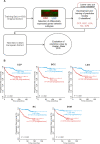Identification of S100A8-correlated genes for prediction of disease progression in non-muscle invasive bladder cancer
- PMID: 20096140
- PMCID: PMC2828413
- DOI: 10.1186/1471-2407-10-21
Identification of S100A8-correlated genes for prediction of disease progression in non-muscle invasive bladder cancer
Abstract
Background: S100 calcium binding protein A8 (S100A8) has been implicated as a prognostic indicator in several types of cancer. However, previous studies are limited in their ability to predict the clinical behavior of the cancer. Here, we sought to identify a molecular signature based on S100A8 expression and to assess its usefulness as a prognostic indicator of disease progression in non-muscle invasive bladder cancer (NMIBC).
Methods: We used 103 primary NMIBC specimens for microarray gene expression profiling. The median follow-up period for all patients was 57.6 months (range: 3.2 to 137.0 months). Various statistical methods, including the leave-one-out cross validation method, were applied to identify a gene expression signature able to predict the likelihood of progression. The prognostic value of the gene expression signature was validated in an independent cohort (n = 302).
Results: Kaplan-Meier estimates revealed significant differences in disease progression associated with the expression signature of S100A8-correlated genes (log-rank test, P < 0.001). Multivariate Cox regression analysis revealed that the expression signature of S100A8-correlated genes was a strong predictor of disease progression (hazard ratio = 15.225, 95% confidence interval = 1.746 to 133.52, P = 0.014). We validated our results in an independent cohort and confirmed that this signature produced consistent prediction patterns. Finally, gene network analyses of the signature revealed that S100A8, IL1B, and S100A9 could be important mediators of the progression of NMIBC.
Conclusions: The prognostic molecular signature defined by S100A8-correlated genes represents a promising diagnostic tool for the identification of NMIBC patients that have a high risk of progression to muscle invasive bladder cancer.
Figures






References
-
- Pow-Sang JM, Seigne JD. Contemporary management of superficial bladder cancer. Cancer Control. 2000;7(4):335–339. - PubMed
-
- Cordon-Cardo C, Zhang ZF, Dalbagni G, Drobnjak M, Charytonowicz E, Hu SX, Xu HJ, Reuter VE, Benedict WF. Cooperative effects of p53 and pRB alterations in primary superficial bladder tumors. Cancer Res. 1997;57(7):1217–1221. - PubMed
Publication types
MeSH terms
Substances
LinkOut - more resources
Full Text Sources
Medical
Miscellaneous

